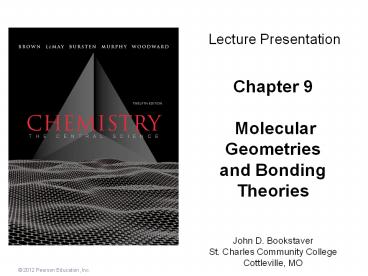Chapter 9 Molecular Geometries and Bonding Theories - PowerPoint PPT Presentation
Title:
Chapter 9 Molecular Geometries and Bonding Theories
Description:
Lecture Presentation Chapter 9 Molecular Geometries and Bonding Theories John D. Bookstaver St. Charles Community College Cottleville, MO ... – PowerPoint PPT presentation
Number of Views:236
Avg rating:3.0/5.0
Title: Chapter 9 Molecular Geometries and Bonding Theories
1
Lecture Presentation
Chapter 9 Molecular Geometriesand Bonding
Theories
John D. Bookstaver St. Charles Community
College Cottleville, MO
2
Molecular Shapes
- The shape of a molecule plays an important role
in its reactivity. - By noting the number of bonding and nonbonding
electron pairs, we can easily predict the shape
of the molecule.
3
What Determines the Shape of a Molecule?
- Simply put, electron pairs, whether they be
bonding or nonbonding, repel each other. - By assuming the electron pairs are placed as far
as possible from each other, we can predict the
shape of the molecule.
4
Electron Domains
- We can refer to the electron pairs as electron
domains. - In a double or triple bond, all electrons shared
between those two atoms are on the same side of
the central atom therefore, they count as one
electron domain.
- The central atom in this molecule, A, has four
electron domains.
5
Valence-Shell Electron-Pair Repulsion Theory
(VSEPR)
- The best arrangement of a given number of
electron domains is the one that minimizes the
repulsions among them.
6
Electron-Domain Geometries
- Table 9.1 contains the electron-domain
geometries for two through six electron domains
around a central atom.
7
Electron-Domain Geometries
- All one must do is count the number of electron
domains in the Lewis structure. - The geometry will be that which corresponds to
the number of electron domains.
8
Molecular Geometries
- The electron-domain geometry is often not the
shape of the molecule, however. - The molecular geometry is that defined by the
positions of only the atoms in the molecules, not
the nonbonding pairs.
9
Molecular Geometries
- Within each electron domain, then, there might
be more than one molecular geometry.
10
Linear Electron Domain
- In the linear domain, there is only one molecular
geometry linear. - NOTE If there are only two atoms in the
molecule, the molecule will be linear no matter
what the electron domain is.
11
Trigonal Planar Electron Domain
- There are two molecular geometries
- Trigonal planar, if all the electron domains are
bonding, - Bent, if one of the domains is a nonbonding pair.
12
Nonbonding Pairs and Bond Angle
- Nonbonding pairs are physically larger than
bonding pairs. - Therefore, their repulsions are greater this
tends to decrease bond angles in a molecule.
13
Multiple Bonds and Bond Angles
- Double and triple bonds place greater electron
density on one side of the central atom than do
single bonds. - Therefore, they also affect bond angles.
14
Tetrahedral Electron Domain
- There are three molecular geometries
- Tetrahedral, if all are bonding pairs,
- Trigonal pyramidal, if one is a nonbonding pair,
- Bent, if there are two nonbonding pairs.
15
Trigonal Bipyramidal Electron Domain
- There are two distinct positions in this
geometry - Axial
- Equatorial
16
Trigonal Bipyramidal Electron Domain
- Lower-energy conformations result from having
nonbonding electron pairs in equatorial, rather
than axial, positions in this geometry.
17
Trigonal Bipyramidal Electron Domain
- There are four distinct molecular geometries in
this domain - Trigonal bipyramidal
- Seesaw
- T-shaped
- Linear
18
Octahedral Electron Domain
- All positions are equivalent in the octahedral
domain. - There are three molecular geometries
- Octahedral
- Square pyramidal
- Square planar
19
Larger Molecules
- In larger molecules, it makes more sense to talk
about the geometry about a particular atom rather
than the geometry of the molecule as a whole.
20
Polarity
- In Chapter 8, we discussed bond dipoles.
- But just because a molecule possesses polar bonds
does not mean the molecule as a whole will be
polar.
21
Polarity
- By adding the individual bond dipoles, one can
determine the overall dipole moment for the
molecule.
22
Polarity
23
Overlap and Bonding
- We think of covalent bonds forming through the
sharing of electrons by adjacent atoms. - In such an approach this can only occur when
orbitals on the two atoms overlap.
24
Overlap and Bonding
- Increased overlap brings the electrons and nuclei
closer together while simultaneously decreasing
electron electron repulsion. - However, if atoms get too close, the internuclear
repulsion greatly raises the energy.































